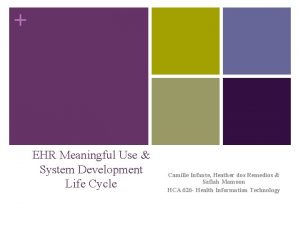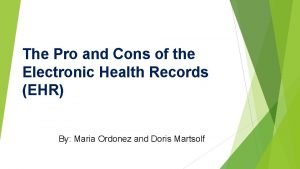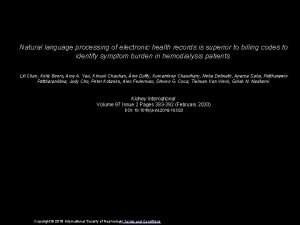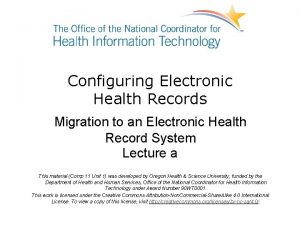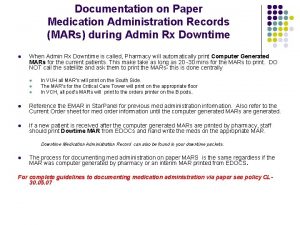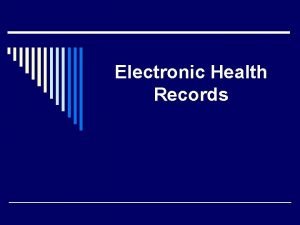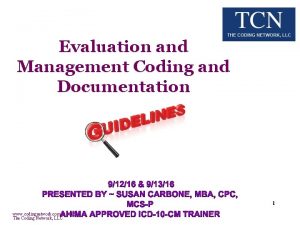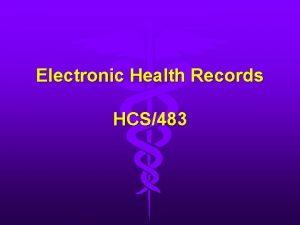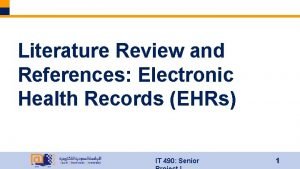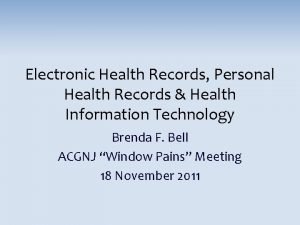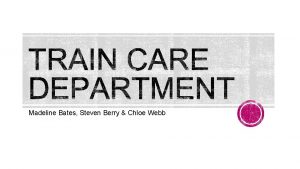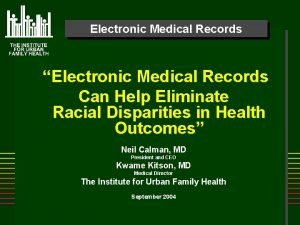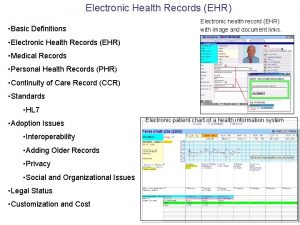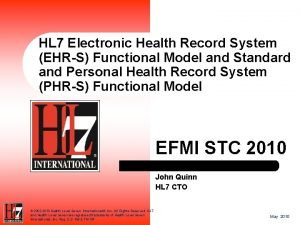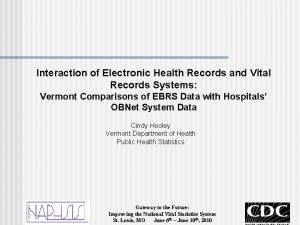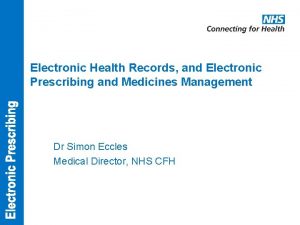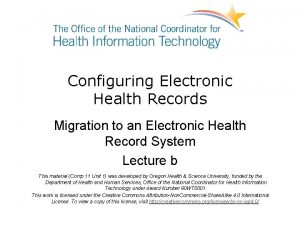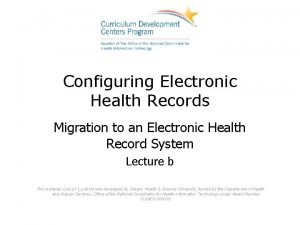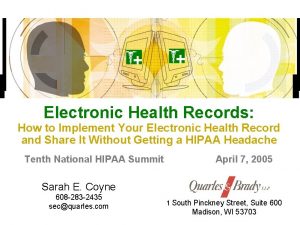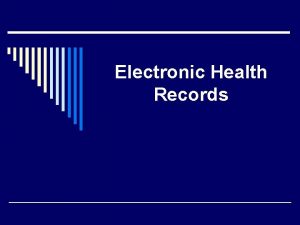Electronic Health Records EHRs Madeline Jefferson WRIT 3405
























- Slides: 24

Electronic Health Records (EHRs) Madeline Jefferson WRIT 3405 W University of Minnesota

Overview 01 02 03 04 05 What are EHRs Effects on Healthcare System Audience Analysis Communication Concerns Current and Future Work

What are Electronic Health Records? • Electronic Health Record: An electronic version of a patient’s medical history that is updated by the provider or other medical staff and typically includes: • • • Progress notes Demographics Medication history Diagnostic results Vital signs Immunizations • A patient portal • integrated decision support tool • Algorithms for drug-drug interaction • Suggestions for treatment • Alert systems

What are Electronic Health Records? “EHRs are the next step in the continued progress of healthcare that can strengthen the relationship between patients and clinicians. The data, and the timeliness and availability of it, will enable providers to make better decisions and provide better care. ” -Centers for Medicare & Medicaid (cms. gov)

EHR Content date allergies diagnoses demographics location vitals provider procedures problem list active meds patient encounter meds prescribed immunizations medical history specialty labs notes

A Brief History of EHRs Ancient Egyptians & Mesopotamians begin documenting medical encounters and ailments 1800 -1920 s: documenting medical encounters on public paper documentation became standard. Still, many physicians keep private journals. Mid-1960 s: Larry Weed, MD, created the Problem-Oriented Medical Record (POMR) which aimed to allow a third party to verify diagnosis. • focused on: a patient problem list, history, physical examination, laboratory initial plans, daily progress notes, and discharge summary

A Brief History of EHRs 1970 -1980 s: Department of Veteran Affairs implements EHRs such as: • Decentralized Hospital Computer Program (DHCP) • Veterans Health Information System and Technology Architecture (Vist. A) • Computerized Patient Record System (CPRS) Vist. A system declared available for unrestricted use in public and private sector

A Brief History of EHRs 1980 s and 1990 s: With the costs for computers decreasing and the introduction of World Wide Web these systems begin to be widely adopted 1996: All EHRs/EMRs become subject to HIPAA regulations February 2009, The American Reinvestment & Recovery Act (ARRA) enacted that includes measures for meaningful use

Effects on the Healthcare System: Advantages • Interactive • Harder to overlook alerts than printed paper reminders • Addresses physician handwriting issues • Take up little space • Better organization than paper filing system • Less risk of data loss • Faster • Reduces extra procedures • Decision support • Collaborative • Can share data • Patient specific feedback available in real time

Effects on the Healthcare System: Disadvantages • Can be expensive: • Implementation • Maintenance • IT • Time consuming • Implementation • Training • Require reliable operation • Can be distracting in patientphysician interaction • Limited functionality depending on title • Reliant on context • Privacy concerns

Effects on the Healthcare System • 62% of studies reviewed found “unambiguously positive” patient outcomes • Decision Support Systems were found to be very effective for patient safety • EHRs increased patient satisfaction and adherence to treatment plans, reduced cost and improved productivity. • Nonetheless, Atasoy et al. identified a lot of common problems.

Audience Analysis • Who is the writing in EHRs for? • • Other Health Professionals Patients Insurance Company Auditors Lawyers, Jurors, Judges Yourself Data Scientists/Health Informatics Professionals

Activity: Part 1 1) 2) 3) 4) Break into groups of two or three Go to this site: https: //www. open-emr. org/demo/ Choose the ”Open. EMR 5. 0. 1 Main Demo” under Open. EMR Demo Log in using: Username: physician Password: physician 5) Explore this system! Try adding in a new patient. Try adding in a new encounter.

Activity: Part 2 1) Choose one group member to role play as a physician and one as a patient 2) If you are the patient: Imagine you are Phil, a patient in an appointment at the doctors office for a suspected ear infection. You are allergic to penicillin and are very nervous the doctor might prescribe the wrong medication 3) If you are the physician: Locate Phil’s file and add in a new Open Encounter, take notes on the appointment and save them. Also try to locate where you can send him a message with information about at home care.

How did it go? Thoughts?

Communication Concerns • “Much evidence suggests that the EHR has potential to undermine development and maintenance of healing relationships if physicians devote too much noncollaborative attention to keyboarding and gazing at the EHR. ” • But, patient portals can also increase trust and improve patient outcomes.

Communication Concerns: Rathert et al. • Rathert et al. found that using EHRs affects body language: • Looking at a screen and keyboard reduce eye contact and face orientation. This has been found to be related to less patient disclosure. • Turning the body away from the patient and toward the screen can influence patient divulgence especially with psychological disorders. • EHRs increased silence and reduced communication as patients would wait while physician typed. • EHRs also affect the narrative: • Breaking rapport into text fields can break up the story of who the patient is and why they are here. • Does this reduce empathy?

Communication Concerns: Rathert et al. • EHR interfaces can create new problems ion the patient-physician interaction: • Poorly designed interfaces cause physician to shift attention to system more than on the patient. • They are time consuming to learn proficiently. • There are higher risks of typos than handwriting (autocorrect). • There is still a degree of uncertainty surrounding EHRs: • Physicians can be resistant to adopting a new system. • Patients are concerned about data breaches or unauthorized access of data.

Communication Concerns: Rathert et al. • But, patient portals incorporated into many EHRs clearly demonstrate many benefits: • Patients can share information they are not comfortable discussing face-toface. • Using a patient portal was correlated with higher medication adherence. • Patient portals lead to increased self-reported patient outcomes.

Current & Future Work: Common Systems Epic

Current & Future Work: Common Systems Next. Gen

Current & Future Work: Common Systems Praxis

Current & Future Work: Health Informatics: The study of acquiring, storing, retrieving and using healthcare information • Areas of work: • Assess systems for patterns to identify what areas need work • AI and Machine learning can create insights into treatment and outcomes • Virtual & mobile medicine • Easily test efficacy of decision-support tools • Big Data and Small Data inferences • Create more accurate demographic information

Citations • Atasoy, H. , Greenwood, B. N. , & Mc. Cullough, J. S. (2019). The Digitization of Patient Care: A Review of the Effects of Electronic Health Records on Health Care Quality and Utilization. Annual Review of Public Health, 40(1). • Evans, R. S. (2016). Electronic Health Records: Then, Now, and in the Future. Yearbook of Medical Informatics, (Suppl 1), S 48–S 61. • Medicare, C. for, Baltimore, M. S. 7500 S. B. , & Usa, M. (2012, March 26). Overview. Retrieved February 22, 2019. • Rathert, C. , Mittler, J. N. , Banerjee, S. , & Mc. Daniel, J. (2017). Patient-centered communication in the era of electronic health records: What does the evidence say? Patient Education and Counseling, 100(1), 50– 64. • Wani, D. , & Malhotra, M. (2018). Does the meaningful use of electronic health records improve patient outcomes? Journal of Operations Management, 60(1), 1 – 18.
 System development life cycle of electronic health records
System development life cycle of electronic health records Pros and cons of electronic health records
Pros and cons of electronic health records Electronic health records
Electronic health records Language
Language +electronic +health +records +migration
+electronic +health +records +migration Writ of habeas data
Writ of habeas data Writ of assistance
Writ of assistance The writ of habeas corpus and the grand jury both
The writ of habeas corpus and the grand jury both Writ jurisdiction in sri lanka
Writ jurisdiction in sri lanka Writ of habeas corpus definition
Writ of habeas corpus definition Uncontrollable spending ap gov
Uncontrollable spending ap gov Paper medication administration record
Paper medication administration record Paper vs electronic medical records
Paper vs electronic medical records Uncitral model law on electronic signatures
Uncitral model law on electronic signatures Electronic medical records
Electronic medical records Electronic medical records
Electronic medical records Scrip exchange
Scrip exchange Electronic news gathering and electronic field production
Electronic news gathering and electronic field production Did madeleine astor survive the titanic
Did madeleine astor survive the titanic Madeline adeane
Madeline adeane Madeleine leininger teori
Madeleine leininger teori Madeline moore grant
Madeline moore grant Price of a leased vehicle is known as the
Price of a leased vehicle is known as the Madeleine leininger
Madeleine leininger Problem-based learning lesson plan examples
Problem-based learning lesson plan examples
